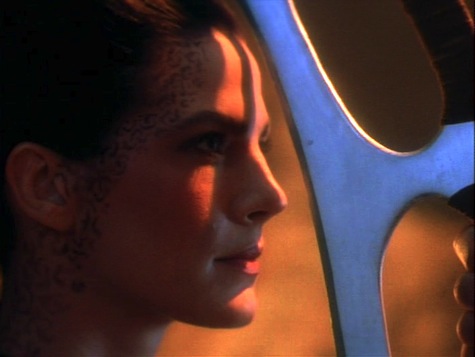“Blood Oath”
Written by Peter Allan Fields
Directed by Winrich Kolbe
Season 2, Episode 19
Production episode 40512-439
Original air date: March 27, 1994
Stardate: unknown
Station log. Quark summons Odo to get a Klingon out of a holosuite. He’s in past his paying time, and he won’t leave, threatening to kill Quark if he shuts off power to the holosuite. He’s reenacting the Battle of Klach D’Kel Bracht, poorly, according to Quark. Odo orders him to shut off the power. “He’ll kill you!” Quark says. “No,” Odo points out, “he’ll kill you.”
Quark cuts the power, and a very old Klingon holding a mostly empty bottle of booze stumbles out. Odo declares him the victor and says the people are waiting to celebrate his victory. “Lead the way then!” the Klingon drunkenly declares, and Odo dumps him in a cell to sleep it off.
Another old Klingon, this one in uniform and calling himself Koloth, shows up in Odo’s office without him knowing. Koloth identifies the prisoner as being Kor, and them both as Dahar masters. Odo actually apologizes, and offers to release Kor to Koloth’s custody—but when Koloth sees how drunk Kor is, he tells Odo to keep him, and storms out.
When Odo tells Kira about his “Klingon afternoon,” Dax overhears and recognizes the players. She goes to the security office to find Kor singing very badly. Dax takes responsibility for Kor, who remembers Curzon Dax as one of his oldest friends—and is rather surprised to realize that Jadzia is the new host.
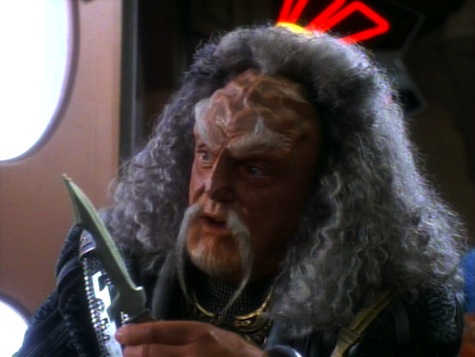
They find Koloth at the replimat, using a dagger to cut his cake. He’s equally shocked at the new Dax host, as is Kang, who arrives dramatically, announcing that 81 years later, he has finally found the Albino. Dax, making it clear that the blood oath she took as Curzon 81 years ago to wreak vengeance on the Albino for killing the first-born sons of all three Klingons still applies to her, takes them to her quarters, where Kang explains that he has found the Albino on Secarus IV, where he’s been living for 25 years.
Kang and Dax walk and talk along the Promenade. Dax tells Kang that Curzon was deeply honored by Kang’s making Curzon godfather to his son—the same one the Albino killed. Kang also didn’t know that Curzon was dead—for security reasons, the four of them have avoided staying in touch with each other. Kang laments the good old days, talking about how Klingons are now opening restaurants and serving racht to the grandchildren of people he killed in battle. He releases Dax from the blood oath.
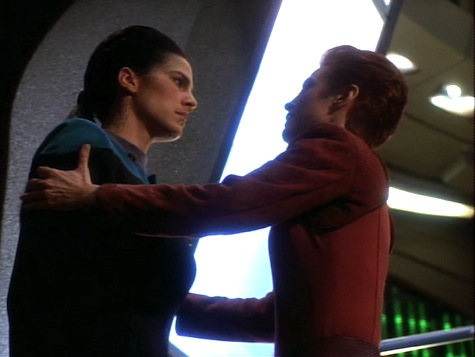
In Ops, Dax asks Kira some rather blunt questions about how many people she killed while she was in the underground. Kira’s evasive-yet-honest answer is “too many.” After prompting from Kira—who doesn’t particularly want to have this conversation—Dax gives the full story: Kang, Kor, and Koloth were sent after some pirates 81 years ago. The leader of the pirates was an albino who evaded capture, and swore to kill the first-born sons of all three Klingons. He was successful a few years later.
Kira insists that Dax has no obligation to them, as it’s Curzon’s blood debt, and Dax admits that Kang feels the same way. But she feels obligated. Dax still remembers the funeral of Kang’s son, who was named Dax for Curzon.
So Dax gets to work on the Klingons. She starts with Kor, who’s drinking with a couple of dabo girls. Kor is on her side, but he doesn’t feel he can change Kang’s or Koloth’s minds. He laments that he was once far less than can be seen (patting his belly) and far more than he has become.
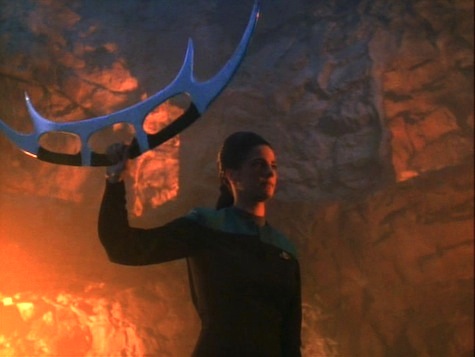
Koloth is next, up in the holosuite practicing with his bat’leth. He dismisses Curzon’s participation in the blood oath as a political gamble to curry favor and make his job easier. He also believes that Dax would be a liability. To prove otherwise, she has the holosuite give her a bat’leth of her own. She gives him a good fight, though Koloth does win eventually—however, he deems her worthy of being included in the quest.
Kang, though, refuses to allow her to come along. Dax, for her part, refuses to give up, pointing out that he can’t let her dishonor herself by not fulfilling the oath. Kang won’t let her die in Curzon’s place, but she has no intention of dying—Kang finally gives in. “Come and fight with us—come and be damned!”
However, Dax has one more obstacle: Sisko, who refuses to grant her a leave of absence. Dax, though, will disobey a direct order if she has to, so Sisko lets her go.
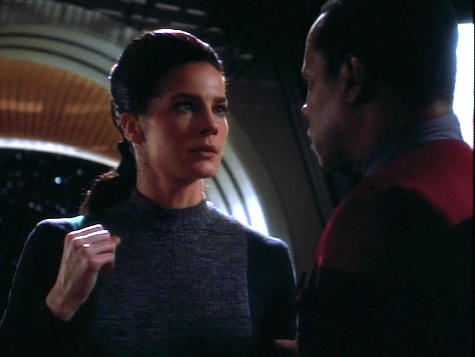
On Kang’s ship, he shows the others the layout. There are 40 guards posted at standing intervals 75 meters apart. Dax thinks that’s insane: no patrols, and too far away to see each other? They don’t think the Albino’s that stupid, but Kang says it doesn’t matter. They will assault directly upon the Albino’s fortress—which strikes Dax as equally insane. It’s not a battle plan, it’s a suicide plan.
Kang finally admits to the real reason why he didn’t want Dax along. He’s been in contact with the Albino and made a deal with him for one last glorious battle. It is, Kang says, their last chance.
However, Dax is a Star Trek science officer, so she proposes another way involving technobabble: bombard the surface with tetryons, which will make the guards’ energy weapons useless. It’s not something Curzon would’ve been able to do, but it’s right up Jadzia’s alley.
The quartet beam down. We see at least one roving patrol, so there’s one lie, and then Dax’s tricorder reveals a mine at the very threshold Kang agreed they’d attack at. So much for honorable combat. Koloth determines that the Albino is truly inside—given the other deceptions, it would just figure that he would go so far as to not even be there—so Dax sets up a diversion at the armory (by blowing it up) while the others destroy the fortress’s sensors.
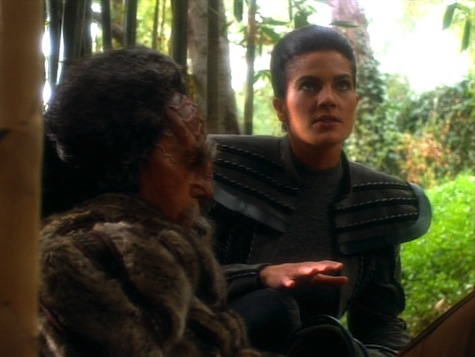
To the Albino’s credit, he doesn’t fall for the diversion and immediately figures out that the phasers don’t work because of something being done by a cloaked ship in orbit. However, without phasers, the guards are comparatively easy prey. Still, the numbers are still 10-1 against our heroes, and Koloth and Kor are both wounded, Koloth fatally so.
Kang, though, makes it all the way to the Albino—who’s been hiding behind the guards. However, the Albino wins the fight and stabs Kang after shattering his bat’leth. Dax threatens him with her bat’leth, but she can’t strike the killing blow. The Albino decides to torment her a bit, but his villainous gloating proves his undoing, as it gives Kang a chance to stab him in the back with his d’k tahg. Kang dies, thanking Dax for letting him strike the killing blow. Only Kor and Dax survive.
Dax returns to Deep Space 9 and takes her station, exchanging silent, significant looks with a peeved Sisko and an understanding Kira.
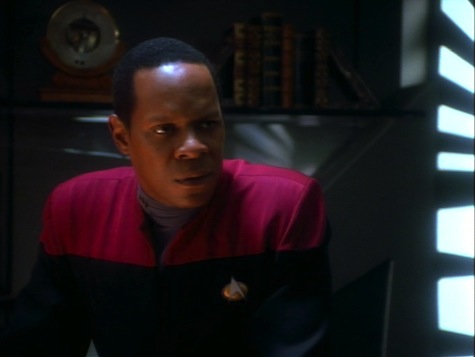
The Sisko is of Bajor. Sisko has been a bit of an apologist for Curzon’s behavior in the past (notably in “Dax” and “The Forsaken” and “Invasive Procedures”), but he flat-out says he doesn’t get the blood oath, doesn’t get Curzon swearing to murder someone.
Don’t ask my opinion next time. Kira is Dax’s best sounding board, as she’s been down this road too many times before in her life, and she warns Dax that when you kill someone, you kill a bit of yourself too. Dax hits a nerve when she asks if the people she killed were all faceless Cardassians or if they were actually people. (Of course, we know one of her victims was a Bajoran, but never mind…)
The slug in your belly. We already knew that Curzon was a Federation negotiator, and we learn in this episode that he had quite a history with the Klingons. Kang credits him with being the first Federation diplomat who actually understood Klingons. (One wonders if he ever worked with Riva…)
What happens on the holosuite stays on the holosuite. Quark got some holosuite programs of ancient Klingon battles from a Klingon captain who came through the wormhole, including the Battle of Klach D’Kel Bracht. There’s apparently also a generic cave program that’s perfect for bat’leth drills.
Preservation of mass and energy is for wimps. Odo has never rolled his eyes so many times in so short a period of time as he does in the teaser and Act 1, most of them revolving around Kor’s drunkenness. He complains to Kira of having “a Klingon afternoon,” a particularly entertaining Odo Rant (pat. pending).
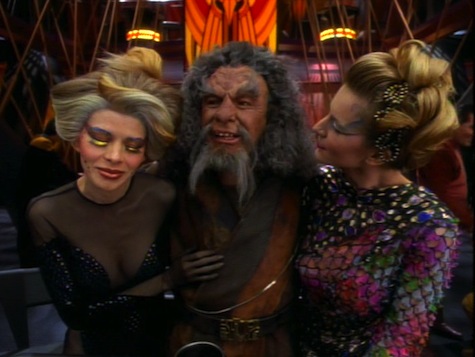
No sex, please, we’re Starfleet. As soon as he realizes that Dax is now a woman, Kor wants to kiss her. She talks him down to a hug. Later, we see him with, not one, but two dabo girls.
Keep your ears open. “There is tension on your face, Koloth! You ought to drink more!” –Kor giving useful advice while Koloth and Dax are sparring.
Welcome aboard. Christopher Collins, who played a different Markalian in “The Passenger,” is the Markalian assistant to the Albino; he also showed up twice on TNG, as Captain Kargan in “A Matter of Honor” and Grebnedlog in “Samaritan Snare.” Bill Bolender plays the Albino, and does a fine job of making you really hate the sonofabitch with only a few lines.
But the big guests here are the triumphant returns of original series guests Michael Ansara as Kang, first seen in “The Day of the Dove,” William Campbell as Koloth, first seen in “The Trouble with Tribbles,” and John Colicos as Kor, the very first Klingon we ever met, in “Errand of Mercy” (Koloth and Kor show up again on the animated series, in “More Tribbles, More Troubles” and “The Time Trap,” respectively, but they were both voiced by James Doohan). This is Campbell’s only appearance on DS9, though he also played Trelane in the original series’ “The Squire of Gothos.” Ansara will return as Jeyal in “The Muse,” and also reprise the role of Kang in Voyager’s “Flashback.” Colicos will come back twice more as Kor in “The Sword of Kahless” in the fourth season and “Once More Unto the Breach” in the seventh.
Trivial matters: This episode drove a stake into the heart of one of the many theories proposed as to why Klingons looked mostly human in the original series but had cranial ridges starting in Star Trek: The Motion Picture. One notion was that there were simply two types of Klingons, the ones with smooth heads and the ones with ridges, but Kang, Kor, and Koloth appearing in this episode with ridges, after being without in their original series appearances, put the kibosh on that one. The explanation for the discrepancy would at last be provided in the Enterprise episodes “Affliction” and “Divergence.”
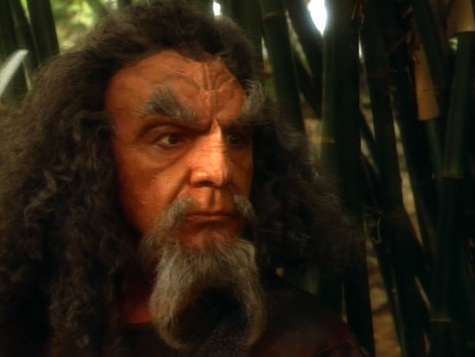
This episode spells out that Trills are not required to carry the obligations of previous hosts forward. It would’ve been nice if someone brought this up in “Dax,” but Jadzia had good reason to stay quiet about Curzon’s indiscretions there, so she wasn’t about to help the case against her.
Klach D’Kel Bracht will be established in the Enterprise episode “The Augments” as the Klingon name for the region known as the Briar Patch, first seen in Star Trek Insurrection.
This is the first time a bat’leth has appeared on DS9. It is far from the last, especially once Klingons become a major presence in the fourth season.
Kor makes a comment about Kang making a deal with the devil. Hilariously, Kang said in “Day of the Dove” that Klingons have no devil.
The backstory of this episode is told in the Excelsior novel Forged in Fire by Andy Mangels & Michael A. Martin, detailing the burgeoning friendship among Curzon Dax and the three Klingons (which should totally be a band name). That same novel serves to explain how Klingons all wound up with ridges again, and also gives the Albino’s name as Qagh.
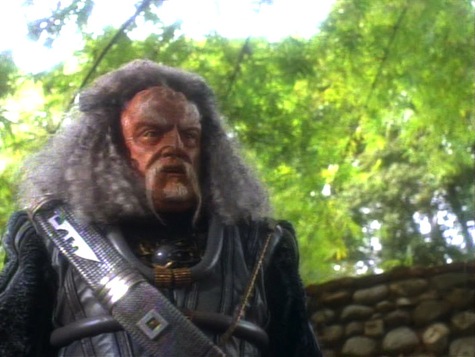
By virtue of their appearances on the original series, the number of pieces of tie-in fiction featuring Kor, Kang, and/or Koloth are legion, and their showing up eight decades of story time later on DS9 just made them more prolific, so listing all the times they were used in prose and comics form would take forever. However…
Koloth featured heavily in Dayton Ward’s In the Name of Honor, attempting to reconcile the dandy of “The Trouble with Tribbles” with “the iceman” of this episode. (The novel also provides one of the pre-Enterprise attempts to reconcile the smooth-head-vs.-bumpy-head conundrum.) Koloth also played a major supporting role in the Errand of Vengeance and Errand of Fury trilogies by Kevin Ryan. Koloth’s last mission before going after the Albino was seen in a brilliant backup story in DC’s Star Trek: The Next Generation Special #3, “Old Debts” by Ryan, Ken Save, & Shephard Hendrix (he wanted his last revenge against his enemies, including against Scotty for leaving all those tribbles in his engine room). Koloth won’t actually appear onscreen in “Trials and Tribble-ations,” but Dax’s memories of Koloth’s stories about his encounter with Kirk at Station K-7 will play a role in the episode.
Kor shows up in a couple of works by your humble rewatcher: the Lost Era novel The Art of the Impossible, in which Curzon Dax is able to get some important information from Kor, and the Slings and Arrows novella Enterprises of Great Pitch and Moment, where Jadzia Dax and Worf are able to do likewise. (In both cases, they find him getting drunk at a particular bar.) He also appears in two of the Day of Honor novels, Treaty’s Law by Dean Wesley Smith & Kristine Kathryn Rusch and Armageddon Sky by L.A. Graf.
Kang is the focus of your humble rewatcher’s Alien Spotlight: Klingons comic book, art by JK Woodward, which shows him at three points in his life, one of which is him caring for the Albino’s discarded wife on Dayos IV until she dies, as mentioned in this episode. He also appears in The Art of the Impossible, playing a role in the ascension of K’mpec (from TNG’s “Sins of the Father” and “Reunion”) to power.
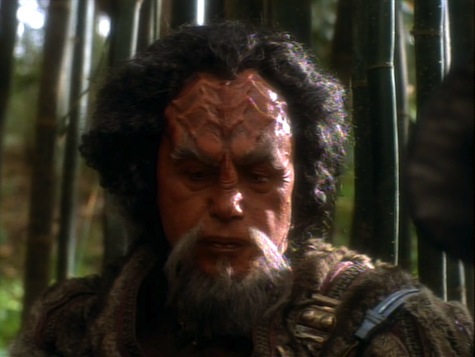
The beginning of the friendship among the three Klingons in the 23rd century is shown in your humble rewatcher’s novella “The Unhappy Ones” in the Seven Deadly Sins anthology. Their TOS appearances were also shown from a Klingon perspective in three issues of the IDW comic book miniseries Blood Will Tell by Scott & David Tipton and David Messina.
Your humble rewatcher’s upcoming tome The Klingon Art of War will provide the origin of the term Dahar master, and will also feature anecdotes regarding Kor, Kang, and Koloth.
Walk with the Prophets. “Look upon your executioners, killer of children!” What a great episode. It’s an epic story of vengeance and camaraderie and betrayal and glory and ethics, it’s got a big beautiful look to it (the best TV director in Trek history, Winrich Kolbe, was very much the right person for this), and it’s a showcase for five superb actors at the top of their game.
The choice to have the three most prominent Klingons from the original series reprise their roles can be viewed as contrived, especially since the only one who acts the same as he did in the 1960s is Michael Ansara. Still, it’s been a very long time, and people do change as they age. The only one that is hard to swallow is Koloth, who was a prissy fussbudget in “The Trouble with Tribbles” and is so totally not that here; on the other hand, it’s not much of a stretch for the Kor of “Errand of Mercy” to age into Falstaff.
In truth, the choice can be viewed as self-indulgent—but it also adds a lot more meaning to the story. A lot of why Klingons became a major part of Trek lore was due to the sheer charisma of these three actors (if the only Klingons we ever saw were the two doofuses from “Friday’s Child” and “A Private Little War,” nobody would’ve given a damn), and having these three be the guest protagonists of this particular tale adds weight.*
*At least, if you recognize them. Zack Handlen of The AV Club had forgotten that these were the same Klingons from the original series in his review of “Blood Oath,” and it didn’t affect his good opinion of the episode in either direction. To him, it was just an added detail for eagle-eyed fans, but made the story neither more nor less effective.
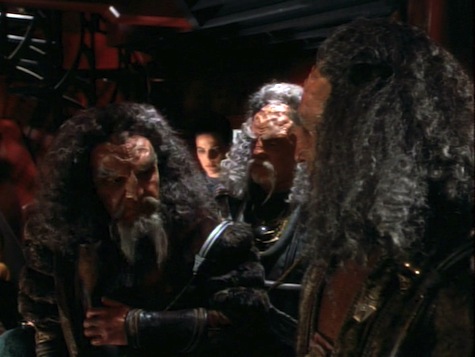
Plus, the three of them are so good. Michael Ansara has more gravitas than pretty much anyone, although here’s it’s leavened by a weary exhaustion. He’s still the unquestioned leader of the group, and everything rotates around him. Ansara has the kind of charisma that the best leaders exude: always the center of the room the moment they walk into it. (It’s what made him a worthy adversary for Kirk in “Day of the Dove,” as he took over the screen every time he was on it.) But you also get the sense that he’s had enough, viewing himself as a relic of a bygone age, and wants to go out in the blaze of glory he feels he and his friends deserve. (He tries to cut Dax out only after he realizes that he isn’t an old man close to death anymore. His biased view of his old friend Curzon is someone who would want to go down swinging with his old buddies, and the revelation that she’s a young woman now alters his decision.)
William Campbell sets the tone of the incredibly focused old warrior who’s seen and done it all and only isn’t dead because he hasn’t yet met anyone worthy of killing him. (He’s actively offended by the notion of dying before Kor does.) His first scene, when he gets the drop on Odo, is a crowning moment of awesome. (“How did you get in here?” “I am Koloth.” “That doesn’t answer my question.” “Yes, it does.”)
But John Colicos is the heart of the trio. Ansara has the voice and Campbell the attitude, but Colicos brings the entire package. He has superb comic timing, the best one-liners, and yet still carries the emotional weight of the quest. His joy at reliving the Battle of Klach D’Kel Bracht over and over, his urgency when asking Kang if he’s finally found the Albino, his snarking off of Koloth in the replimat and on the holosuite, his bitter words to Kang when the latter’s betrayal is revealed, and his last words to Koloth promising that Klingon children will forevermore hear the story of his honorable life and glorious death.
Terry Farrell gets her second strong outing in three episodes, with the benefit of a much better storyline than she got in “Playing God.” I like the fact that Dax isn’t a hundred percent comfortable in the role of warrior woman—she handles herself competently when they storm the Albino’s lair, but not overwhelmingly, and tellingly she loses her fight with Koloth. And in the end, after her agonizing with both Sisko and Kira, when given the chance to kill the Albino, she doesn’t take it. She’ll defend herself (and she doesn’t kill any of the guards, either), but even though she feels the emotional need to avenge the death of her godson, she can’t do what Curzon swore to do eight decades earlier. Kang dies thinking she let him get the final blow, and it’s probably better that he believed that, but it’s obvious from Farrell’s expression, both in the fortress and back on DS9, that that’s not it at all.
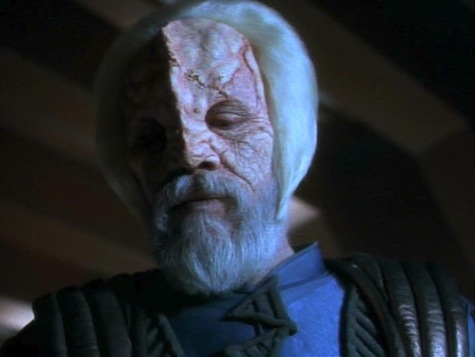
Speaking of the Albino, it tends to get lost in the hugger mugger of bringing the big three back that Bill Bolender gives a delightfully nasty-ass performance here. The Albino’s only onscreen for a little bit, but he lives up to his billing. He sees through most of their tricks, anticipates their tactics, and is also a spectacular asshole, hiding behind his employees, referring to Kor, Kang, and Koloth as “Klingon filth,” still taking joy in his execution of three children, and then finally his condescending (if perceptive) talk with Dax.
Sisko and Kira’s roles in this episode are nice reminders that what we’re talking about here is still pretty icky. It’s played for laughs when Kor goes on about how awesome it’ll be when they wade into battle and spill craptons of blood and who wouldn’t want that? But Sisko reminds the audience that we’re talking about taking a life, and Kira is there to tell us just what that means. They manage this while still maintaining Trek’s trademark cultural relativism: as Dax points out, this is Klingon justice, the proper moral way for a Klingon warrior to behave toward the person who killed his son.
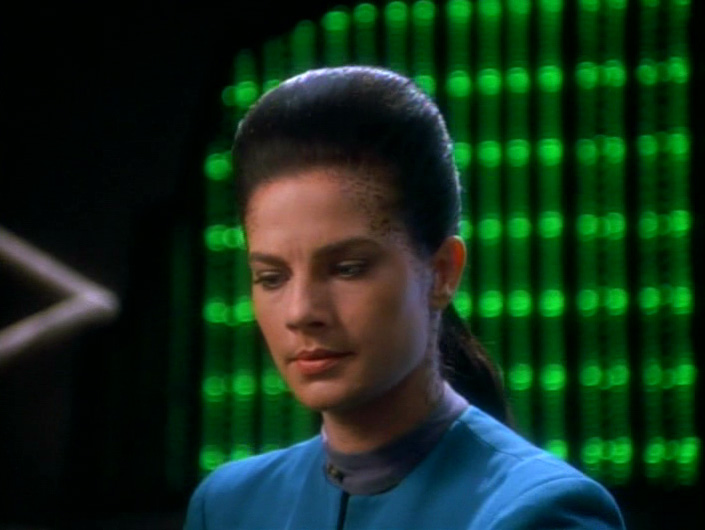
Best of all is the ending. Peter Allan Fields, more than any other Trek scripter, understands the value of a good silence, particularly at the end of an episode. The final scene works so much better for not having any dialogue, relying on the facial expressions of three actors (Farrell, Avery Brooks, Nana Visitor) who are really good at them in any case to carry the ending’s power.
Warp factor rating: 9
Keith R.A. DeCandido has written a butt-load of Klingon-focused fiction, including the novels Diplomatic Implausibility, A Good Day to Die, Honor Bound, Enemy Territory, A Burning House, and The Art of the Impossible, not to mention Articles of the Federation, A Singular Destiny, and A Time for War, a Time for Peace, which have plenty of Klingony goodness; short stories in Tales from the Captain’s Table, Mirror Universe: Shards and Shadows, and Seven Deadly Sins; the comic book Alien Spotlight: Klingons; and next year’s coffee-table book The Klingon Art of War.










